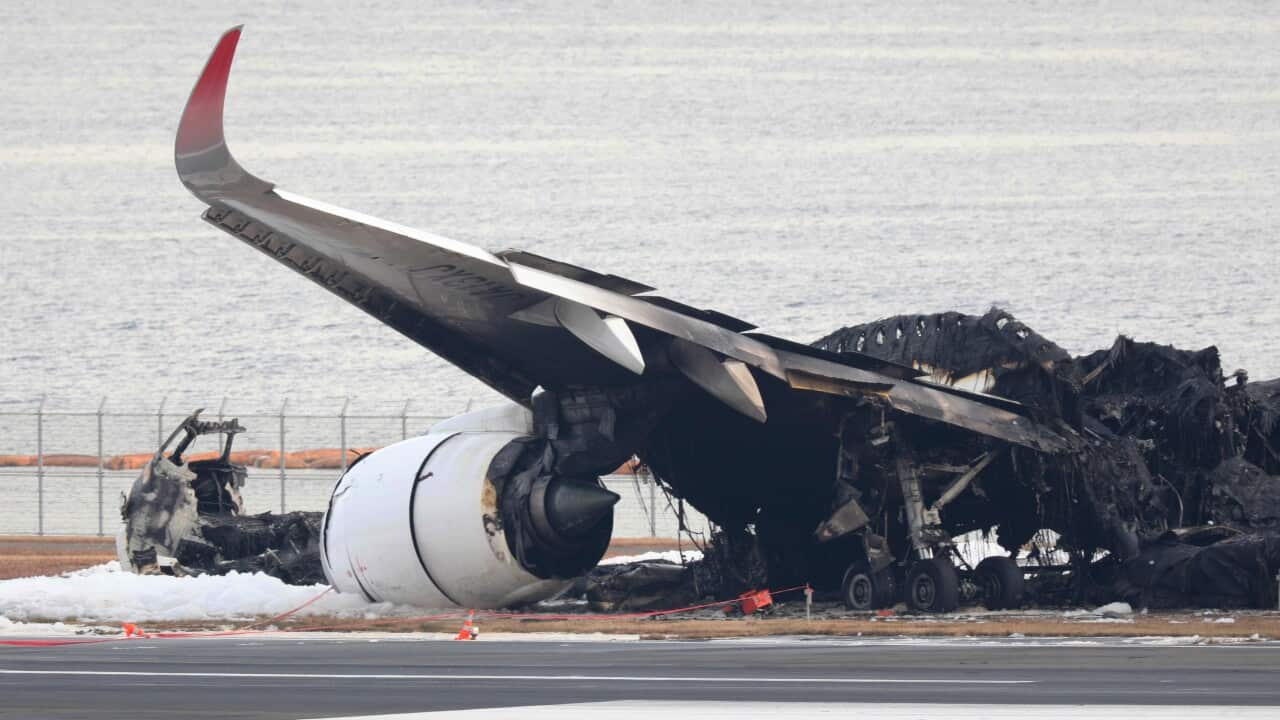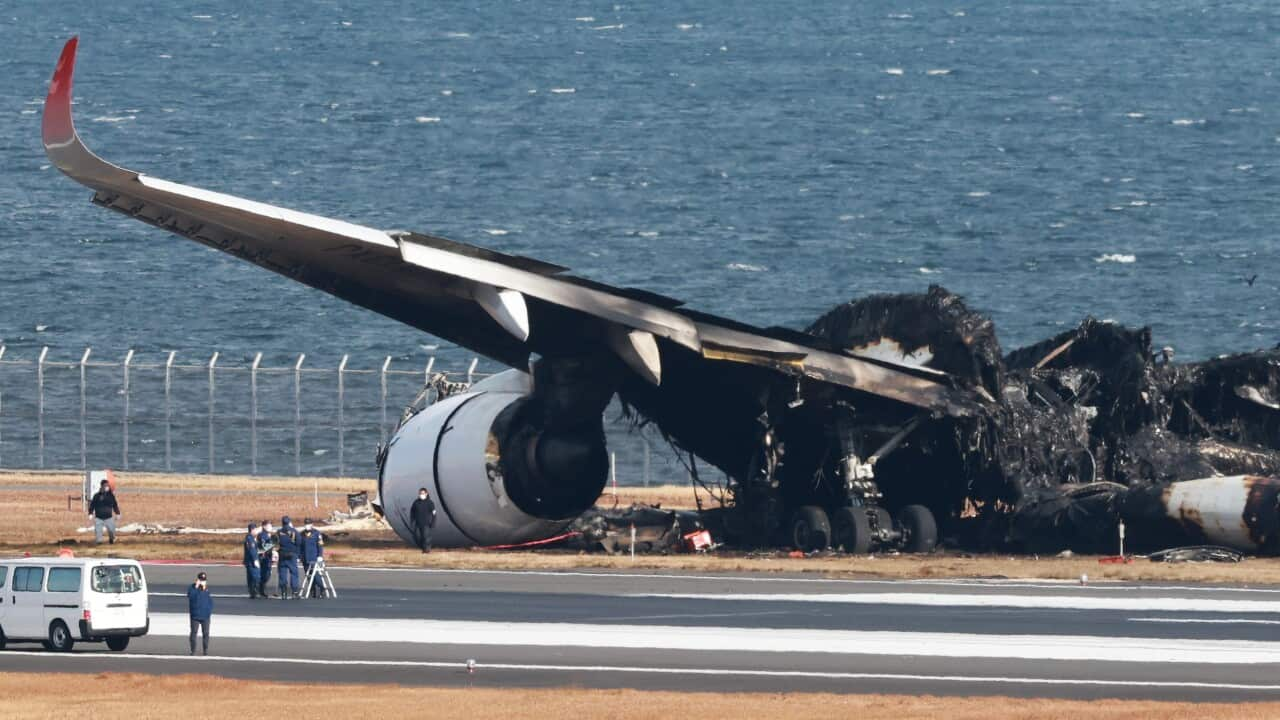"In the case of an emergency, passengers must leave all belongings on board and immediately proceed to the nearest usable exit."
It's a familiar instruction to anyone who has been on an aircraft, and one that may have contributed to the passengers onboard the Japan Airlines Airbus A350 at Tokyo's Haneda Aiport surviving on Tuesday.
Haneda Airport incident
Vision from the JAL plane's landing, after colliding with a Coast Guard aircraft on a runway, showed passengers streaming out of the plane's front exits quickly, without any hand luggage.
Aviation experts told SBS news many plane incidents like this one were survivable, but dependent on multiple factors, including passenger behaviour.
In this case, all 367 passengers and 12 crew on the commercial flight managed to escape the plane and survive.
However, five of the six people on board the Coast Guard plane - which had been preparing to head to Japan's west coast to deliver aid to those affected by the - were killed.
Passengers and their carry-on luggage
Sonya Brown, a senior lecturer in aerospace design at the University of New South Wales, said key to the fast evacuation of the Airbus A350 was the fact passengers did not attempt to retrieve their carry-on luggage.
She said doing so could slow down an escape and damage the inflatable escape slides.
"The big important thing about that warning (to disregard personal belongings) is it's about potential blockages," Brown said.

Experts say leaving baggage behind in an emergency situation is an important element for a successful evacuation. Source: Getty / Jackyenjoyphotography
"So it is really important that people do leave their belongings behind."
Brown acknowledged that while in some emergencies, not everyone would do that, the more people who did, the better people's chances of escaping .
Layers of safety designed for survival
While many have described the outcome for those on the passenger plane as "miraculous", Matt Ebbatson, manager of learning innovation at the RMIT Aviation Academy, told SBS that in this case, "the system worked as it was intended to work" in response to the accident.
"Many layers of safety have been designed in for that outcome to be predictable. It's multi-layered, so it's not one thing, really, but there are many, many key factors."
Cabin crew and fire officers on the ground
Brown stressed that while systems were in place to help people safely escape, the crew onboard were a vital element.
"The crew did a fantastic job to get everyone off the aircraft," she said.
Brown described footage taken from within the JAL aircraft that showed the cabin filling with smoke.
"The crew directions and the crew trying to keep everyone as calm as possible [are] so crucial to get everyone out on time," she said.
Ebbatson also praised the crew's ability to get the entire planeload of passengers out of the aircraft before the flames reached those onboard under the circumstances.

The Japan Airlines plane seen on fire on the runway of Haneda Airport. Source: AAP / AP
"In this case, half of the exits weren't usable, because of the orientation of the aeroplane, with its nose leaning down."
Ebbatson said another factor that likely played a part in the outcome for those on the Airbus was the speed of the response from fire services on the ground to reach the aeroplane and work on slowing the spread of the fire.
Aircraft design
Ebbatson said today's aircraft had been designed with safety and surviving an accident in mind.
"If you look back in the 80s, where we had similar accidents, which turned out not to be survivable, the big changes are the structure of the aeroplane and a lot to do with the internal materials used in an aeroplane.
Ebbatson said improvements to "the design of the exits on aeroplanes and the spacing of the aisles as you approach those exits" had made for smoother evacuations.
He said the types of materials used within the cabin, including fabrics and materials that make up the seats and structures within the cabins, were also replaced with more fire-resistant alternatives.

The Airbus A350 is a popular commercial aircraft around the world. Source: Getty / Tomohiro Ohsumi
Would the outcome in Australia be similar?
Brown said she was confident Australian airlines, cabin crew and airports would be able to respond to any such incidents in a similar way to how the Japan incident had been dealt with.
"I'd be very confident here in Australia, we would see a similar outcome," she said.
"Certainly, aircraft are made to be as survivable as possible, and particularly for what we consider emergency landings."
However, Brown emphasised that there's "always a level of risk", and acknowledged the five lives that had still been lost from those on the Coast Guard plane.
Air crash investigations ongoing
The full picture of how the accident occurred is not yet known. Police in Tokyo and the Japan Safety Transport Board are both still investigating the incident.
Airline Ratings editor Geoffrey Thomas told SBS that "according to Japan Airlines, their crew had been given permission to land".
"At this stage, we don't know why the Coast Guard aircraft was on the runway, we can only at this stage, speculate that there was confusion between air traffic control and the pilots of the Coast Guard aircraft."
Thomas said once investigators listened back to air traffic control conversations, what happened would become clearer.










